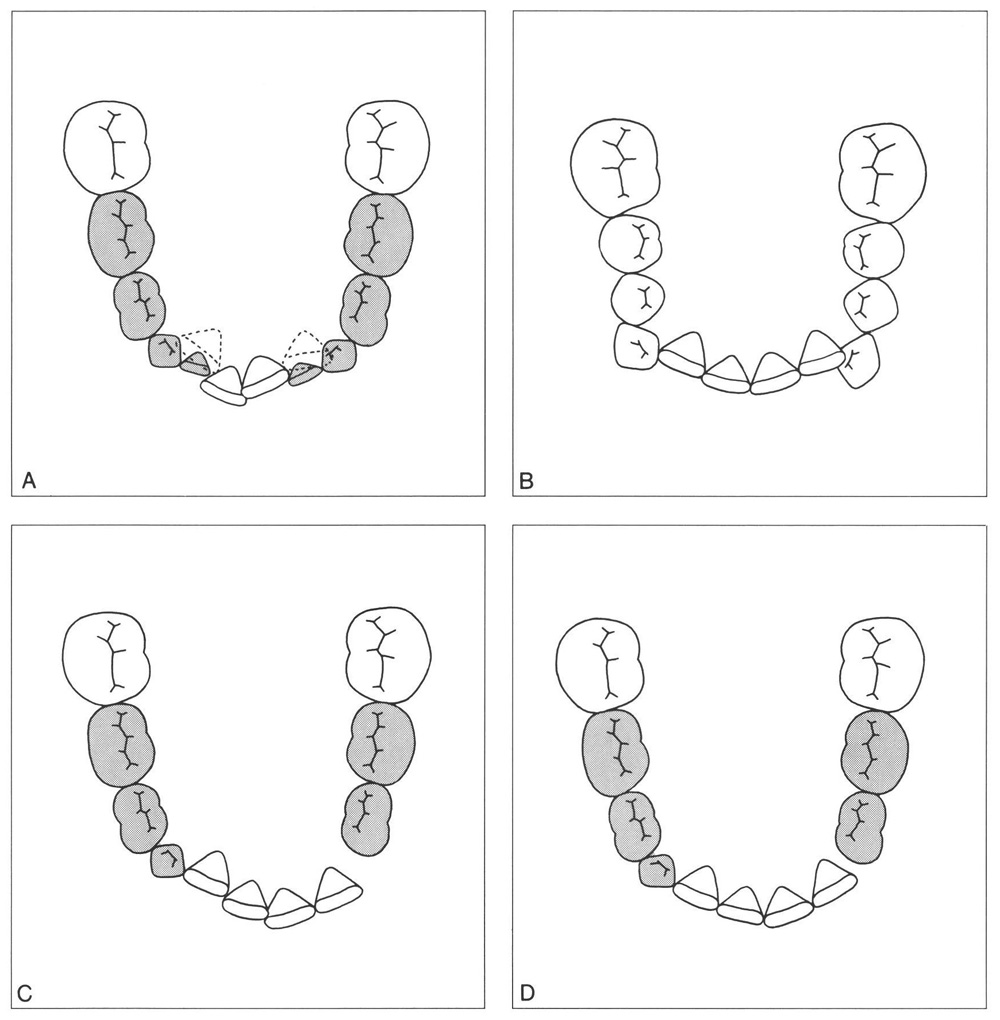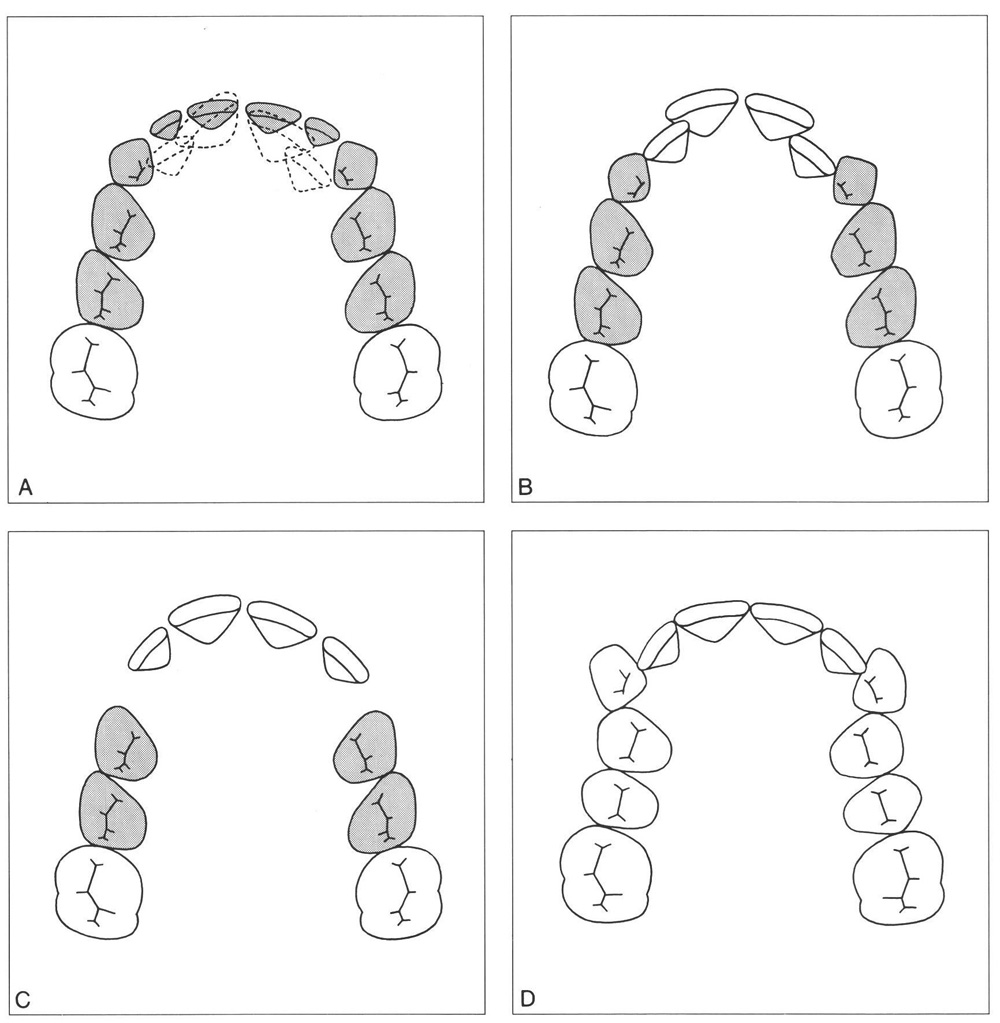Premature Loss and Extraction of Deciduous Incisors and Canines
Spontaneous premature loss of a deciduous incisor or canine occurs when the emergence of a permanent incisor is associated with resorption of the root of its predecessor and that of one of the adjacent deciduous teeth. Most children and parents are unaware of premature loss of a deciduous tooth and if they do notice it do not consider it abnormal. Loss of one or more teeth due to a blow is a more dramatic occurrence.
Premature loss of deciduous teeth through resorption because of crowding is an early sign of pronounced arch length discrepancy (ALD). However, later crowding in the permanent dentition can only be prevented or corrected by increasing the arch length or extracting permanent teeth. Both solutions usually require orthodontic appliances. A satisfactory result can occasionally be achieved with serial extraction* without appliances.
The consequences of spontaneous premature loss of deciduous incisors and canines are only seen some years later. During the second transitional period inadequate space for the permanent canines becomes apparent. When the premature loss was unilateral the midline of the dental arch will have deviated toward the side where the premature loss occurred.
Sometimes the deciduous canines will have been removed by a dentist to prevent or correct irregularity of the permanent incisors. This intervention has only a temporary effect. The existing crowding is not eliminated but is displaced distally along the arch. Extracting deciduous incisors and canines with the aim of favourably influencing dental development may only be undertaken after careful analysis and devising of a full treatment plan. The indications for it are limited. In general, planned extraction of deciduous teeth will be followed sooner or later by extensive orthodontic treatment. In this chapter the important differences between mandible and maxilla will be addressed. The consequences of premature loss, and the symptoms that point to forthcoming premature loss, will be shown. Above all, the indicators will be given of what to do when unilateral premature loss is expected. The indications and contraindications for early extraction of deciduous canines are dealt with. The limited alternatives are pointed out. Prevention and cure of detrimental consequences are presented.
9.2 Morphological differences between mandible and maxilla
In the mandible permanent teeth can cross the midline even before emergence. There is no longer a partition between right and left halves of the jaw once the symphysis is calcified before the emergence of the deciduous incisors. The crowding in the mandible can concentrate itself, as it were, on one side. In the maxilla the median palatal suture remains in existence and cannot be crossed by teeth. The crowns of the maxillary central incisors can, after emergence, migrate mesially and tip. But the roots do not cross the suture. Hence, unilateral spontaneous early loss is seen more often in the mandible than the maxilla.
In the mandible the crowns of the central permanent incisors are narrower than those of the lateral incisors, hence a lateral deciduous incisor seldom is lost prematurely from the mandible. On the other hand, premature resorption and loss of the mandibular deciduous canine occurs relatively often. In the maxilla with its wide central permanent incisors, premature loss of the lateral deciduous incisor is quite likely. The root of the deciduous canine in the maxilla resorbs prematurely less often than in the mandible. This difference stems primarily from the greater space available for the emerging maxillary lateral incisor to migrate as compared to the limited space in the mandible. Further consideration will not be given here to the underlying difference between the jaws respecting the positions of the permanent teeth before emergence, their crown dimensions, and the size of the anterior section of the apical area. These aspects have been treated extensively in preceding chapters.
9.3 Consequences of premature loss through resorption
The early creation of extra space in the dental arch assists improvement of the positions of the permanent incisors already present or as yet unerupted. Rotations can self-correct, overlaps can reduce. Against this is the fact that the increase in the intercanine width that normally ensues in association with the transition of the incisors does not occur after premature loss of deciduous teeth that are essential for this increase. The available arch length is usually negatively influenced by the premature loss of deciduous incisors and canines. Unilateral premature loss, or bilateral loss with a significant time difference between times of loss, leads to a deviation of the midpoint of the dental arch (Figs. 9-1 and 9-2).

Fig. 9-1 Changes in the mandibular arch associated with premature loss of deciduous canines resulting from resorption.
A Lateral permanent incisors in a crowded dentition can emerge in a better position if, before their emergence, the deciduous canine and lateral deciduous incisor have exfoliated.
B Later there is insufficient room in the dental arch for the permanent canine. Moreover, the mandibular incisors have tipped lingually.
C Unilateral premature loss through resorption of a deciduous canine is associated with an asymmetric arrangement of the mandibular permanent incisors.
D Subsequently the mandibular incisors move further to the side of the premature loss; the midpoint of the dental arch deviates still more.

Fig. 9-2 Changes in the maxillary arch associated with premature loss of deciduous teeth resulting from resorption.
A Central permanent incisors in a crowded dentition can emerge in a better position if, before their emergence, the lateral and central deciduous incisors have exfoliated.
B The lateral permanent incisors will generally emerge palatally; there is insufficient room for them in the dental arch.
C If not only the lateral deciduous incisors but also the deciduous canines are exfoliated early because of resorption, the lateral permanent incisors can emerge into the arch.
D Subsequently there is insufficient space in the dental arch for the permanent canines, which usually will emerge on the labial aspect of the alveolar process.
Displacement of a tooth before formation is complete can give rise to deformation of the root. This can be seen in a mandibular lateral permanent incisor after unilateral premature loss of a deciduous canine.227
9.4 Symptoms of impending premature loss through resorption
Lack of diastemata in the deciduous dentition indicates a small anterior section of the apical area, and abnormal crowding can develop with the emergence of the permanent incisors.225 Premature exfoliation can be expected.
Emergence of a central permanent incisor across the midline of the mandible can point up a displacement of the midpoint of the arch that has already been present before the teeth emerged. Account then needs to be taken of the likelihood of early resorption of the root of the deciduous canine and its premature loss on the side where there is most crowding.
Resorption of the deciduous teeth is associated with increased mobility. Early increase in mobility indicates that premature loss is imminent. A difference between left and right sides would suggest that unilateral exfoliation is likely. This also applies to a midpoint deviation of the dental arch combined with crowding.
9.5 What to do in cases of (impending) unilateral early loss
In cases of i/>
Stay updated, free dental videos. Join our Telegram channel

VIDEdental - Online dental courses


